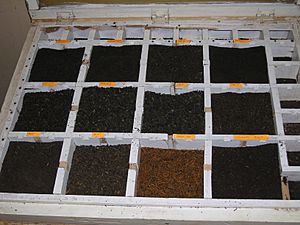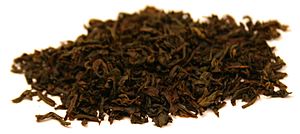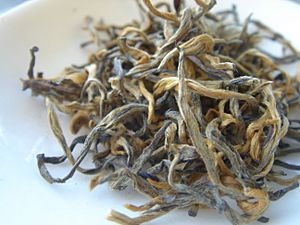Tea leaf grading facts for kids
In the tea world, tea leaf grading is how we sort and rate tea leaves based on their quality and condition. It's like sorting apples by size and how perfect they look!
For teas from Western countries and South Asia, the best grades are called "orange pekoe." The lowest grades are known as "fannings" or "dust." Pekoe tea grades are sorted by how many young leaves were picked along with the leaf buds. The best pekoe grades only use the leaf buds. These are picked carefully with fingertips to avoid bruising them. Different tea types use different leaf grades. For example, most white tea is made from the buds or young shoots of the tea plant.
When tea leaves are crushed for tea bags, they are called "broken." An example is "broken orange pekoe" (BOP). Lower grades like fannings and dust are tiny bits left over from sorting and crushing.
"Orange pekoe" is often shortened to "OP." There are even higher grades than OP, mainly based on how whole and big the leaves are.
Broken, fannings, and dust teas have slightly different grading systems. CTC teas, which are machine-processed into uniform fannings, have their own special grading system.
Contents
How Tea Leaves Are Sorted
Tea grading systems can be different, but the size of the leaf or broken pieces is always very important. Leaf size affects how you prepare tea. Bigger leaves or pieces usually need more time to steep. Also, if you measure by volume, larger sizes need more tea to make the same strong drink.
Some teas are also graded by how they look. Whole leaves are easier to grade by their appearance than broken pieces.
Understanding Orange Pekoe Tea
Orange pekoe, sometimes spelled pecco or OP, is a term used in the Western tea trade. It describes a certain type of black tea (orange pekoe grading). Even though it sounds Chinese, these grading terms are mostly used for teas from Sri Lanka, India, and other countries, not usually China. This grading system is based on the size of the processed and dried black tea leaves.
The tea industry uses "orange pekoe" to mean a basic, medium-quality black tea. It has many whole tea leaves of a specific size. However, in places like North America, people often use "orange pekoe" to mean any regular black tea. The best grades in this system come from new pickings. This includes the very end leaf bud and a few of the youngest leaves. Grading depends on the "size" of the leaves and how whole they are. This is checked by seeing if they can fall through special mesh screens. The size and wholeness of the leaves greatly affect the taste, clarity, and brewing time of the tea.
When not talking about black tea grading, "pekoe" (or sometimes orange pekoe) means the unopened leaf bud at the end of a tea shoot. So, phrases like "a bud and a leaf" or "a bud and two leaves" describe how many leaves are on a tea shoot. They are also used to mean pekoe and a leaf or pekoe and two leaves.
Where Did the Name "Pekoe" Come From?
No one is completely sure where the word "pekoe" came from. One idea is that it came from a Chinese word for "white down" or "white hair." This refers to the soft, white hairs on the leaf and the youngest leaf buds. Another idea is that it comes from a Chinese word meaning "white flower." This might refer to the buds found in pekoe tea.
Sir Thomas Lipton, a famous British tea seller in the 1800s, is often given credit for making "orange pekoe" popular in Western countries. This term doesn't seem to have a Chinese origin. The "orange" in orange pekoe does not mean the tea tastes like oranges. There are two main ideas about what "orange" means:
- The House of Orange-Nassau was a very respected royal family in the Netherlands. The Dutch East India Company brought a lot of tea to Europe. They might have called the tea "orange" to link it to this famous family.
- The color: The name might come from the copper color of a high-quality tea leaf before it's dried. Or it could be from the bright orange color of the dried pekoes in the finished tea. These leaves usually have one leaf bud and two leaves covered in fine, soft hair. The orange color appears when the tea is fully oxidized.
What Are Fannings?
Fannings are small pieces of tea left over after the higher grades of tea are collected. In the past, these were seen as waste from making high-quality leaf tea like orange pekoe. Fannings with very tiny particles are sometimes called dusts. Fannings and dusts are considered the lowest grades of tea. They are separate from broken-leaf teas, which have larger pieces. However, fannings from expensive teas can still cost more and taste better than whole leaves from cheaper teas.
Even though they were once considered low quality, fannings have become very popular in many parts of the world. This is because tea drinking became common. Tea stalls in India, South Asia, and Africa prefer dust tea. It is cheap and makes a very strong brew. This means more cups of tea can be made from the same amount of tea dust.
Because the particles are so small, a tea infuser is usually needed to brew fannings. Fannings are also commonly used in most tea bags. However, some companies now sell tea bags with whole-leaf tea.
Some tea exporters mainly sell broken-leaf teas, fannings, and dusts.
Tea Leaf Grades Explained
Different terms describe the quality of tea leaves. "Choppy" means many leaves of different sizes. "Fannings" are small tea particles mostly used in tea bags. "Flowery" means large leaves, often picked later in the season, with many tips. "Golden flowery" includes very young tips or buds (which are usually golden). "Tippy" means there are lots of tips.
Whole-Leaf Tea Grades
| Grade | What It Means |
|---|---|
| OP | This is a main grade. It has long, wiry leaves without tips. |
| OP1 | More delicate than OP. It has long, wiry leaves and makes a light-colored tea. |
| OPA | Bolder than OP. It's a long-leaf tea that can be tightly rolled or almost open. |
| OPS | Mostly from Indonesia. It's similar to OP. |
| FOP | A high-quality tea with a long leaf and few tips. It's considered the second best in Assam, Dooars, and Bangladesh, but the best in China. |
| FOP1 | Only the very best leaves in the FOP group. |
| GFOP | Has more tips than FOP. It's a top grade in Milima and Marinyn, but rare in Assam and Darjeeling. |
| TGFOP | Has the most tips. This is the main grade in Nepal, Darjeeling, and Assam. |
| TGFOP1 | Only the very best leaves in the TGFOP group. |
| FTGFOP | This is the highest quality grade. |
| FTGFOP1 STGFOP SFTGFOP |
Only the very best leaves in the FTGFOP group. |
Broken-Leaf Tea Grades
| Grade | What It Means |
|---|---|
| BT | Usually a black, open, and bulky leaf. This grade is used in Sumatra, Sri Lanka, and parts of Southern India. |
| BP | The most common broken pekoe grade. It comes from Indonesia, Sri Lanka, Assam, and Southern India. |
| BPS | The term for broken pekoe in the Assam and Darjeeling areas. |
| FP | High-quality pekoe. It's usually coarser with a fleshier, broken leaf. Produced in Sri Lanka, Southern India, and parts of Kenya. |
| BOP | The main broken grade. Common in Assam, Sri Lanka, Southern India, Java, and China. |
| FBOP | Coarser and broken, with some tips. From Assam, Sri Lanka, Indonesia, China, and Bangladesh. In South America, it's a coarser, black broken tea. |
| FBOPF | The finest broken orange pekoe, with more tips. Mainly from Sri Lanka's "low districts." |
| GBOP | A second-grade tea with uneven leaves and few tips. |
| GFBOP1 | Like GFBOP, but only the highest quality leaves in that group. |
| TGFBOP1 | High-quality leaves with many tips. These are the finest broken First Grade Leaves in Darjeeling and some parts of Assam. |
Fannings Tea Grades
| Grade | What It Means |
|---|---|
| PF | |
| OF | From northern India and some parts of Africa, South America, and Nepal. |
| FOF | Common in Assam, Dooars, Nepal, and Bangladesh. Some leaf sizes are close to smaller broken grades. |
| GFOF | The finest grade in Darjeeling for making tea bags. |
| TGFOF | |
| BOPF | A main grade in Sri Lanka, Indonesia, Nepal, Southern India, Kenya, Mozambique, Bangladesh, and China. It's a black-leaf tea with few added ingredients, even particle size, and no tips. |
Dust Tea Grades
| Grade | What It Means |
|---|---|
| D1 | From Sri Lanka, Indonesia, China, Africa, South America, Southern India, and Bangladesh. |
| PD | |
| PD1 | Mostly made in India. |
Other Tea Terms
- Musc. – Muscatel (a special flavor)
- Cl. – Clonal (from a specific plant type)
- Ch. – China varietal (a type of tea plant from China)
- Qu. – Queen jat (a specific type of tea plant)
- FBOPF Ex. Spl. – Finest Broken Orange Pekoe Flowery (Extra Special)
- FP – Flowery Pekoe
- PS – Pekoe Souchong
- S – Souchong
- BOF – Broken Orange Fannings
- BPF – Broken Pekoe Fannings
- RD – Pekoe Dust / Red Dust
- FD – Fine Dust
- GD – Golden Dust
- SRD – Super Red Dust
- SFD – Super Fine Dust
- BMF – Broken Mixed Fannings




